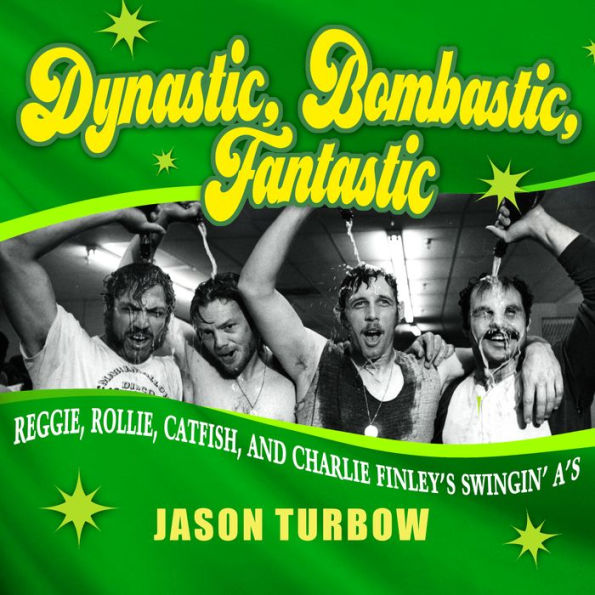01/09/2017
One of the most unusual dynasties in baseball, the Oakland A’s of the 1970s, gets close scrutiny by veteran sportswriter Turbow, author of The Baseball Codes, who details how the team was cleverly assembled and peaked during a turbulent American era. Following a move from Kansas City to the Bay Area in 1967, Finley seizes control of a lackluster squad, stocking it with a roster of talented rogues and rebels including Reggie Jackson, Catfish Hunter, Vida Blue, Sal Bando, Rollie Fingers, and Blue Moon Odom in his quest to achieve postseason honors. Turbow challenges the myth of Finley as a con man and huckster, portraying him as a visionary and promotional genius for his team’s mascot mule, uniform changes, half-price games, and facial hair on players. Conflicts between players in the clubhouse and in the press only propel the team to win five straight division titles, three American League pennants, and three World Series. As the 1970s close, the ailing Finley surrenders to free agency and fire sales of his stars, ending his team’s reign. Turbow’s scholarly account offers a chance to relive a period of outlandish moments in America’s pastime. (Mar.)
The Oakland A's of the early 1970s were the most transformative team in baseball history. Never before had an entire organization so collectively traumatized baseball's establishment with its outlandish behavior and business decisions-or with its indisputable winning record: five straight division titles and three straight championships. The high drama that played out on the field was exceeded only by the drama in the clubhouse and front office. But those A's, with their garish uniforms and outlandish facial hair, redefined soon...virtually every aspect of the game for coming generations.
Under the visionary leadership of Charles O. Finley, the team assembled such luminary figures as Reggie Jackson, Catfish Hunter, Rollie Fingers, and Vida Blue. Finley acted as his own general manager, and, with an insatiable need for control, dictated everything from the playlist of the ballpark organist to the menu for the media lounge. The advent of free agency spelled the end of Finley's reign; within two years, his dynasty was lost.
A sprawling, brawling history of one of the game's most unforgettable teams, Dynastic, Bombastic, Fantastic is a paean to a turbulent yet magical time.
"1124079662"
Under the visionary leadership of Charles O. Finley, the team assembled such luminary figures as Reggie Jackson, Catfish Hunter, Rollie Fingers, and Vida Blue. Finley acted as his own general manager, and, with an insatiable need for control, dictated everything from the playlist of the ballpark organist to the menu for the media lounge. The advent of free agency spelled the end of Finley's reign; within two years, his dynasty was lost.
A sprawling, brawling history of one of the game's most unforgettable teams, Dynastic, Bombastic, Fantastic is a paean to a turbulent yet magical time.
Dynastic, Bombastic, Fantastic: Reggie, Rollie, Catfish, and Charlie Finley's Swingin' A's
The Oakland A's of the early 1970s were the most transformative team in baseball history. Never before had an entire organization so collectively traumatized baseball's establishment with its outlandish behavior and business decisions-or with its indisputable winning record: five straight division titles and three straight championships. The high drama that played out on the field was exceeded only by the drama in the clubhouse and front office. But those A's, with their garish uniforms and outlandish facial hair, redefined soon...virtually every aspect of the game for coming generations.
Under the visionary leadership of Charles O. Finley, the team assembled such luminary figures as Reggie Jackson, Catfish Hunter, Rollie Fingers, and Vida Blue. Finley acted as his own general manager, and, with an insatiable need for control, dictated everything from the playlist of the ballpark organist to the menu for the media lounge. The advent of free agency spelled the end of Finley's reign; within two years, his dynasty was lost.
A sprawling, brawling history of one of the game's most unforgettable teams, Dynastic, Bombastic, Fantastic is a paean to a turbulent yet magical time.
Under the visionary leadership of Charles O. Finley, the team assembled such luminary figures as Reggie Jackson, Catfish Hunter, Rollie Fingers, and Vida Blue. Finley acted as his own general manager, and, with an insatiable need for control, dictated everything from the playlist of the ballpark organist to the menu for the media lounge. The advent of free agency spelled the end of Finley's reign; within two years, his dynasty was lost.
A sprawling, brawling history of one of the game's most unforgettable teams, Dynastic, Bombastic, Fantastic is a paean to a turbulent yet magical time.
27.89
In Stock
5
1

Dynastic, Bombastic, Fantastic: Reggie, Rollie, Catfish, and Charlie Finley's Swingin' A's

Dynastic, Bombastic, Fantastic: Reggie, Rollie, Catfish, and Charlie Finley's Swingin' A's
FREE
with a B&N Audiobooks Subscription
Or Pay
$27.89
$29.99
27.89
In Stock

Editorial Reviews
Product Details
| BN ID: | 2940170127603 |
|---|---|
| Publisher: | HighBridge Company |
| Publication date: | 03/07/2017 |
| Edition description: | Unabridged |
Videos

From the B&N Reads Blog
